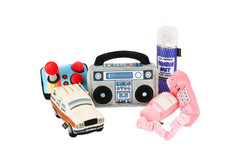Teeth seem to be the most neglected part of your dog's body. While most pet parents will remember to brush their coat until shiny, smooth, and stunning, they will often overlook dental hygiene. However, we can't tell you how important this step is.
It cleans plaque, eliminates bad breath, and prevents various oral-related conditions. But, before you even start brushing their teeth, it's crucial to get your dog used to a toothbrush and toothpaste. That's why we've created this short tutorial to teach you the basic steps.
Find the right moment
It's crucial to brush your dog's teeth when they are relaxed. You want to set up a routine that will work for your pet. While daily tooth brushing is ideal, if they have a healthy mouth, even three days a week will make a significant difference.
If you neglect teeth brushing, plaque can develop, resulting in bad breath, tooth decay, and gum disease. In some cases, your dog can suffer from a painful infection, which can spread quickly and cause life-threatening conditions.
Choose the right tools
You want to use a toothbrush that's specifically designed for dogs. This tool has soft and specially angled bristles. While finger bushes are great for canines under 30 pounds, we suggest getting a brush with a longer handle for larger dogs. This will allow you better reach.
Make sure to use dog toothpaste as well. They come in dog-friendly flavors, like peanut butter or poultry. Under any circumstances, do not use human toothpaste. It contains harmful ingredients, like fluorine which might upset their stomach and, in some cases, lead to poisoning.
Find the appropriate position
Find a spot where your dog feels comfortable. Don't stand above them, hold them aggressively, or take a threatening stance. You should try kneeling or sitting in front of your pet. This will keep them relaxed and prevent any anxiety attacks.
If you notice your dog is upset, stop what you are doing and try again later. It will take some time until you master all these steps.
Prepare their gums
Test your dog's willingness by rubbing a finger across its gums and teeth. This way, they will get used to your fingers in their mouth and that something is rubbing against their teeth. Apply light pressure. You may need to repeat this session several times to get them comfortable.
Test the toothbrush
When your pet is used to your touch, it's time to use dog toothpaste and a toothbrush. Lift their upper lip and start brushing their teeth so you reach a gum line. Try placing the brush at a 45-degree angle. This way, the bristles will massage the gums and remove the plaque.
Apply circular motions
When brushing your dog's teeth, apply small circular motions, getting top and bottom on each side. You might notice light bleeding as you move the toothbrush across the gum line, which is perfectly fine. In case of heavy bleeding, contact your vet immediately because it might be a sign of gum disease, or maybe you are brushing their teeth too aggressively.
Focus on removing plaque
Start by brushing a couple of teeth and then increase the number over time. Make sure to brush their teeth for at least two minutes. If you notice your dog is upset or resists at first, focus on the back teeth and on the outsides, where the plaque tends to collect the most.
If you can reach their insides, great; if not, don't stress too much. Dogs have a coarse tongue that partially cleans the inside of their teeth.
Lighten the mood
You should create a friendly atmosphere while brushing your pet's teeth. Talk to them, so they know exactly what you are doing. Stroke their head and jowls and remind them what a good pup they've been.
Reward your dog
When you are done brushing your dog's teeth, give them their favorite treat or show them extra attention. Keep in mind that good dental care doesn't end with toothpaste and toothbrush. Many products are available on the market that can help you maintain your pet's dental hygiene.
Certain types of treats and dental chews are designed to fight plaque build up. Don't forget to schedule a professional cleaning. Talk to your vet to set up a schedule.
We hope these tips and tricks will help your dog have healthy and strong teeth and teach you the proper way to take care of their pearly whites.





